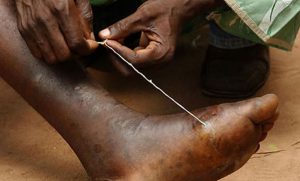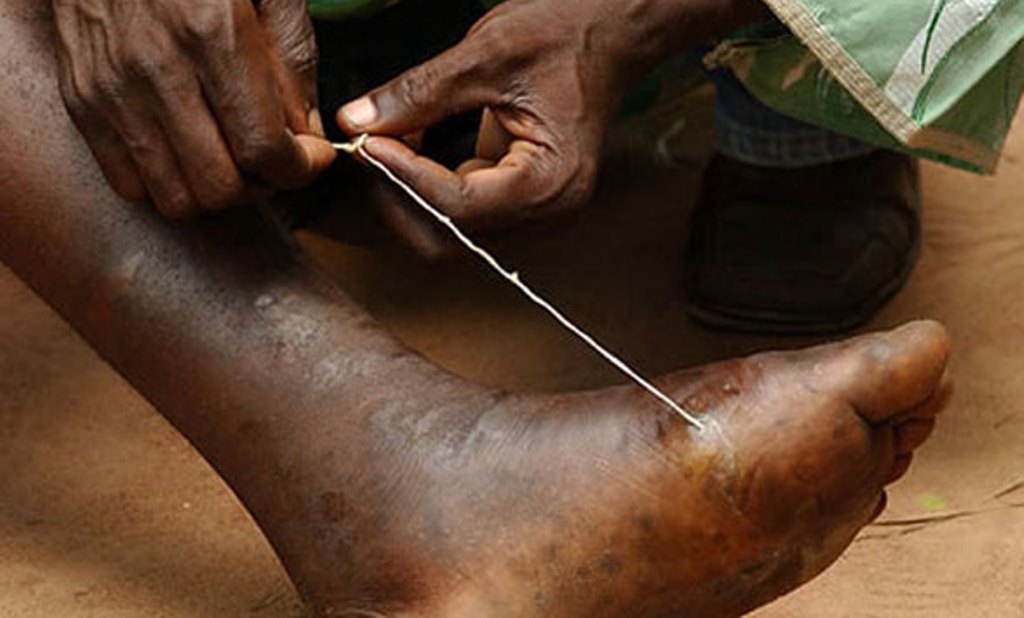
The picture of an individual with dracunculiasis or guinea worm disease, seen above, will soon be a rarity or totally non-existent on earth. According to the World Health Organisation (WHO), only 22 human cases were reported globally throughout 2015, the lowest in history, and there are strong indications that the disease is fast on its way out of the world.
Dracunculiasis (commonly known as guinea-worm disease) is a crippling parasitic disease caused by Dracunculus medinensis – a long, thread-like worm.
It is usually transmitted when people who have little or no access to improved drinking water sources swallow stagnant water contaminated with parasite-infected water-fleas (cyclops) that carry infective guinea-worm larvae.
According to the World Health Organisation (WHO), in the mid-1980s, there were an estimated 3.5 million cases in 21 countries worldwide of which 17 countries were in Africa. In 1988 Nigeria reported the highest number of cases ever reported worldwide, about 653 000 cases, followed by Ghana with 179 000 cases. Both countries have been reporting zero cases since 2013 and 2010 respectively and are in the pre-certification phase.

Now, WHO reports that out of 20 countries that were endemic in the mid-1980s, only 4 countries reported cases in 2015 – (Chad (9), Mali (5), South Sudan (5) and Ethiopia (3)).
To be declared free of dracunculiasis, a country needs to have reported 0 instances of transmission and maintained active surveillance for at least 3 years afterwards.
After this period, an international certification team visits the country to assess the adequacy of the surveillance system and to review records of investigations regarding rumoured cases and subsequent actions taken.
Indicators such as access to improved drinking water sources in infected areas are examined and assessments are carried out in villages to confirm the absence of transmission. Risks of reintroduction of the disease are also assessed. Finally a report is submitted to the International Commission for the Certification of Dracunculiasis Eradication (ICCDE) for review.
A country reporting 0 cases over a period of 14 consecutive months is believed to have interrupted transmission. It is then classified as being in the pre-certification stage for at least 3 years since the last indigenous case, during which intense surveillance activities need to continue. Even after certification, surveillance should be maintained until global eradication is declared.
Since 1995 the ICCDE has met 10 times and on its recommendation WHO has certified 198 countries, territories and areas (belonging to 186 Member States) as free of dracunculiasis.
From more than 650 000 cases in 1988 to zero today, Nigeria has successfully stopped transmission of guinea-worm disease.
The last person known to have had guinea-worm disease in Nigeria was Grace Otubo, a 58-year-old migrant farmer from the remote rural village of Ezza Nwukbor in eastern Nigeria.
“Twenty five years ago, Mrs Otubo would have been just one of more than 650 000 victims of guinea-worm disease,” says Dr Rui Gama Vaz, WHO Representative in Nigeria. “The fact that she can be specifically identified as the final victim of the disease in her country is due to this successful system of surveillance.”
Eradication efforts from WHO and partners, including the Yakubo Gowon Centre, The Carter Center, the Government of Japan and UNICEF, have included improving safe water supply, education and disease awareness, supporting behaviour change and training health workers to recognize and report suspected cases of guinea-worm disease. A cash reward provided an incentive for members of the public to report cases too.
In December 2013, on the recommendation of the WHO certification commission, Director-General, Dr Margaret Chan declared Nigeria free of guinea-worm disease. Dr Chan highlights the successful integration of guinea-worm surveillance into the disease surveillance and polio immunization campaigns: “This is the kind of joined-up effort that makes the most effective use of our human and financial resources, and has a dramatic and measurable impact.”
Since neighbouring countries (Chad, Ethiopia, Mali and South Sudan) still have on-going transmission of guinea-worm disease, Nigeria continues to remain vigilant for cases that might cross the border. Eradicating the disease, which incapacitates infected people for 3 weeks on average, has made an enormous contribution to Nigeria’s social and economic advancement.
Background source: WHO
Prev Post

